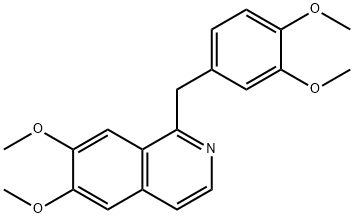PAPAVERINE HYDROCHLORIDE
|
|
PAPAVERINE HYDROCHLORIDE 속성
- 녹는점
- 226 °C
- 끓는 점
- 475.36°C (rough estimate)
- 밀도
- d420 1.337
- 굴절률
- 1.6250 (estimate)
- 용해도
- H2O: 25 mg/mL
- 산도 계수 (pKa)
- 6.4(at 25℃)
- 물리적 상태
- 가루
- 색상
- 하얀색
- 수용성
- 37.33mg/L(37.5℃)
- Merck
- 14,7019
- BRN
- 312930
안전
- 위험 및 안전 성명
- 위험 및 사전주의 사항 (GHS)
| 위험품 표기 | Xn | ||
|---|---|---|---|
| 위험 카페고리 넘버 | 22 | ||
| 안전지침서 | 22 | ||
| 유엔번호(UN No.) | UN 1544 6.1/PG 3 | ||
| WGK 독일 | 1 | ||
| RTECS 번호 | NW8575000 | ||
| F 고인화성물질 | 8 | ||
| 위험 등급 | 6.1(a) | ||
| 포장분류 | II | ||
| 유해 물질 데이터 | 58-74-2(Hazardous Substances Data) | ||
| 독성 | LD50 orl-rat: 325 mg/kg ARZNAD 20,1338,70 |
PAPAVERINE HYDROCHLORIDE C화학적 특성, 용도, 생산
화학적 성질
White crystalline powder; obtained asorthorhombic prisms from an alcohol–ethermixture; melts at 147°C (296.6°F); sublimesunder vacuum; insoluble in water; soluble inacetone, glacial acetic acid, and benzene.용도
folate metabolic inhibitor, coccidiostat정의
ChEBI: A benzylisoquinoline alkaloid that is isoquinoline substituted by methoxy groups at positions 6 and 7 and a 3,4-dimethoxybenzyl group at position 1. It has been isolated from Papaver somniferum.Indications
Papaverine (Pavabid) is a nonspecific phosphodiesterase inhibitor that increases cAMP and cGMP levels in penile erectile tissue. Papaverine is particularly known as a smooth muscle relaxant and vasodilator. Its principal pharmacological action is as a nonspecific vasodilator of smooth muscles of the arterioles and capillaries. Various vascular beds and smooth muscle respond differently to papaverine administration both in intensity and duration. Papaverine decreases the resistance to arterial inflow and increases the resistance to venous outflow.건강위험
Papaverine is an inhibitor of cyclic nucleotidephosphodiesterase, producing vasodilatoryeffect. The acute toxic effects relative tophenanthrene-type opium alkaloids (e.g.,morphine, heroin) are low and the symptomsare not the same. Papaverine is neither a narcoticnor an addictive substance. Excessivedoses may produce drowsiness, headache,facial flushing, constipation, nausea, vomiting,and liver toxicity.The LD50 data reported in the literatureshow variation. An oral LD50 value in rats ison the order of 400 mg/kg.
Mechanism of action
When administered by intracavernosal injection, papaverine, a weak and nonspecific PDE inhibitor, is thought to cause relaxation of the cavernous smooth muscles and vasodilation of the penile arteries by inhibition of PDE. These effects result in increased arterial blood flow into the corpus cavernosa and in swelling and elongation of the penis. Venous outflow also is reduced, possibly as a result of increased venous resistance.Clinical Use
Papaverine is highly effective in men with psychogenic and neurogenic ED but less effective in men with vasculogenic ED. Papaverine–phentolamine combinations have been used in self-injection procedures. Papaverine doses may range from 15 to 60 mg. Papaverine treatment in patients with severe arterial or venous incompetence is usually unsuccessful, but autoinjections using low doses sufficient to achieve an erection are safe and efficient.부작용
Major side effects associated with papaverine therapy include priapism, corporeal fibrosis, and occasional increases in serum aminotransferases. Intracorporeal scarring may be related to the low pH of the vehicle that is necessary to solubilize papaverine.Attempts to buffer papaverine to render it more suitable for intracavernosal injection have not been entirely satisfactory, and such delivery may still lead to intracorporeal scarring.Safety Profile
Poison by ingestion, intramuscular, subcutaneous, intradermal, intraperitoneal, and intravenous routes. Human systemic effects: coma, somnolence. Its central nervous system action is about midway between those of morphme and codeine, and large doses do not produce the amount of excitement caused by codeine or the soporific action of morphine. Mutation data reported. A cerebral vasodilator and smooth muscle relaxant. Combustible when exposed to heat or flame. When heated to decomposition it emits toxic fumes of NOx. See also MORPHINE.PAPAVERINE HYDROCHLORIDE 준비 용품 및 원자재
원자재
5'-아데닐산
PAPAVERINE BASE
Isoquinoline,1-[(3,4-dimethoxyphenyl)methyl]-6,7-dimethoxy-, 2-oxide
Atracurium Impurity 18
준비 용품
PAPAVERINE HYDROCHLORIDE 관련 검색:
Elziverine
ethaverine
Papaverine hydrochloride
Dimoxyline
PAPAVERINE HYDROCHLORIDE
Drotaverin hydrochloride
R-tetrahydropapaverine HCl
(+/-)-Tetrahydropapaverine
R-Tetrahydropapaverine N-acetyl-L-leucinate
BOLDINE DIMETHYL ETHER
(R)-(+)-Tetrahydropapaverine
Tetrahydropapaverine hydrochloride
1-[(3,4-Dimethoxyphenyl)methyl]-3,4-dihydro-6,7-dimethoxyisoquinoline
6,7-DIMETHOXYISOQUINOLINE
1-(2-bromo-4,5-dimethoxybenzyl)-6,7-dimethoxyisoquinoline
ethaverine hydrochloride
TOSLAB 11931
DIOXYLINEPHOSPHATE







